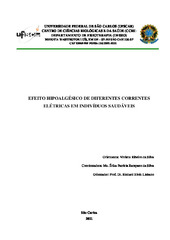| dc.contributor.author | Silva, Viviane Ribeiro da | |
| dc.date.accessioned | 2021-07-13T11:29:45Z | |
| dc.date.available | 2021-07-13T11:29:45Z | |
| dc.date.issued | 2021-06-15 | |
| dc.identifier.citation | SILVA, Viviane Ribeiro da. Efeito hipoalgésico de diferentes correntes elétricas em indivíduos saudáveis. 2021. Trabalho de Conclusão de Curso (Graduação em Fisioterapia) – Universidade Federal de São Carlos, São Carlos, 2021. Disponível em: https://repositorio.ufscar.br/handle/ufscar/14584. | * |
| dc.identifier.uri | https://repositorio.ufscar.br/handle/ufscar/14584 | |
| dc.description.abstract | Transcutaneous electrical nerve stimulation (TENS), interferential current (CI) and Aussie current are different types of electrical stimulation used in the treatment of both acute and chronic pain, however it is not known if there is a difference in relation to the hypoalgesic effect and sensory comfort between them. Therefore, the aim of this study was to compare the hypoalgesic effect and sensory comfort between TENS, CI and Aussie current in healthy individuals. One hundred and twenty individuals were randomly assigned to four groups: TENS, CI, Aussie current and Placebo. The electrical stimulation was administered to the dominant forearm with a strong but comfortable intensity, for 30 minutes to the three groups of electric currents and to the Placebo group, the electrodes were positioned with the equipment turned off. The pressure pain threshold and sensory comfort were measured, respectively, with a digital algometer and visual analog scale. There was a significant segmental and extrasegmental hypoalgesic effect between the active groups compared to the Placebo group at the first 15 minutes of application. At 30 minutes, there was also a significant segmental and extrasegmental hypoalgesic effect between the active groups compared to the Placebo group. After 20 minutes of stimulation, there was no significant segmental difference between groups. And after 20 minutes of stimulation, there was a significant extrasegmental hypoalgesic effect in the active groups compared to the Placebo group. There was no significant difference in sensory comfort between the electrical currents. In conclusion, TENS, CI and Aussie current showed greater segmental and extrasegmental hypoalgesic effect during stimulation compared to Placebo and sensory comfort was similar between them. | por |
| dc.description.sponsorship | Conselho Nacional de Desenvolvimento Científico e Tecnológico (CNPq) | por |
| dc.language.iso | por | por |
| dc.publisher | Universidade Federal de São Carlos | por |
| dc.rights | Attribution-NonCommercial-NoDerivs 3.0 Brazil | * |
| dc.rights.uri | http://creativecommons.org/licenses/by-nc-nd/3.0/br/ | * |
| dc.subject | Algometria | por |
| dc.subject | Limiar de dor por pressão | por |
| dc.subject | Dor | por |
| dc.subject | Estimulação elétrica nervosa transcutânea | por |
| dc.subject | Corrente interferencial | por |
| dc.subject | Corrente Aussie | por |
| dc.title | Efeito hipoalgésico de diferentes correntes elétricas em indivíduos saudáveis | por |
| dc.title.alternative | Hypoalgesic effects of different types of electrical currents in healthy subjects | por |
| dc.type | TCC | por |
| dc.contributor.advisor1 | Liebano, Richard Eloin | |
| dc.contributor.advisor1Lattes | http://lattes.cnpq.br/1397951221512127 | por |
| dc.contributor.advisor-co1 | Silva, Érika Patrícia Rampazo da | |
| dc.contributor.advisor-co1Lattes | http://lattes.cnpq.br/0784752361438422 | por |
| dc.description.resumo | A estimulação elétrica nervosa transcutânea (TENS), a corrente interferencial (CI) e a corrente Aussie são diferentes tipos de estimulações elétricas utilizadas tanto no tratamento da dor aguda como da dor crônica, no entanto não se sabe se há diferença em relação ao efeito hipoalgésico e o conforto sensorial entre elas. Portanto, o objetivo deste estudo foi comparar o efeito hipoalgésico e o conforto sensorial entre a TENS, CI e corrente Aussie em indivíduos saudáveis. Cento e vinte indivíduos foram distribuídos aleatoriamente entre quatro grupos: TENS, CI, corrente Aussie e Placebo. A estimulação elétrica foi administrada no antebraço dominante com intensidade forte, porém confortável, durante 30 minutos aos três grupos de correntes elétricas, e ao grupo Placebo, os eletrodos foram posicionados com o equipamento desligado. O limiar de dor por pressão e o conforto sensorial foram medidos, respectivamente, com um algômetro digital e a escala visual analógica. Houve um efeito hipoalgésico segmentar e extrassegmentar significativo entre os grupos ativos em comparação ao grupo Placebo aos 15 primeiros minutos de aplicação. Aos 30 minutos, houve também um efeito hipoalgésico segmentar e extrassegmentar significativo entre os grupos ativos em comparação ao grupo Placebo. Após 20 minutos da estimulação não foi observado diferença significativa segmentar entres os grupos. E após 20 minutos da estimulação, houve um efeito hipoalgésico extrassegmentar significativo nos grupos ativos em comparação ao grupo Placebo. Não houve diferença significativa em relação ao conforto sensorial entre as correntes elétricas. Como conclusão, a TENS, CI e corrente Aussie apresentaram maior efeito hipoalgésico segmentar e extrassegmentar durante a estimulação comparado ao Placebo e o conforto sensorial foi semelhante entre elas. | por |
| dc.publisher.initials | UFSCar | por |
| dc.subject.cnpq | CIENCIAS DA SAUDE::FISIOTERAPIA E TERAPIA OCUPACIONAL | por |
| dc.publisher.address | Câmpus São Carlos | por |
| dc.contributor.authorlattes | http://lattes.cnpq.br/2401198652400879 | por |
| dc.publisher.course | Fisioterapia - Fisio | por |

